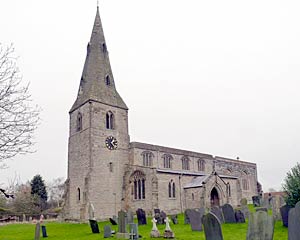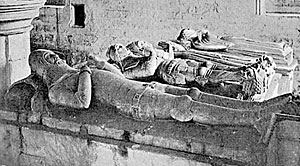< Previous | Contents | Next >
The Famous Willoughbys

Church of St Mary and All Saints, Willoughby in 2014. © Copyright Alan Murray-Rust and licensed for reuse under this Creative Commons Licence.

Willoughby family monuments, 1907.
WILLOUGHBY-ON-THE-WOLDS. It gave its name to a great family seven hundred years ago, and has a fine old church where some of them lie. A part of their old home remains in the farmhouse and cottage near the church. The first of them was Ralph Bugge, a rich Nottingham merchant who bought land here in the 13th century; his son changed his name to Willoughby. In the next century they were in possession of Wollaton, and had begun a long association with that village which ended only in 1924, when the splendid house they built in Elizabeth's reign became one of Nottingham's great possessions.
Their splendid monuments are in the 14th century chapel of the church, which has nothing older than the 12th century nave arcades. A hundred years later are the tower and spire, the chancel (with modern windows), and its arch. The clerestory is about 1500. The font, the fine piscina, and part of a stone altar, are medieval, and a 20th century screen is a thankoffering for peace.
The stone figures of Sir Richard de Willoughby (a cross-legged knight of 1325) and his wife represent the parents of another Sir Richard—a famous Lord Chief Justice, who lies on his alabaster tomb in his robes of office, with a sword and a roll in his hand. It was his marriage that brought Wollaton to the family. The alabaster figure of his son Richard lies between the chapel and the aisle, on a tomb enriched with heraldic shields. On a splendid tomb with sculptured figures in 18 niches lies Sir Hugh Willoughby of 1448, wearing richly decorated armour and a wreathed helmet. With him is one of his wives in a long gown, a cape tied with a tasselled cord, and a mitred headdress. There are also two ancient stone figures of women in wimples.
A small brass in the floor of the north aisle marks the resting-place of Michael Stanhope of Shelford, who was slain "in Willoughby Field in 1648, being a soldier for King Charles the First." This was the last struggle of the Civil War in Notts, when the Royalists under Sir Philip Monckton were routed by Colonel Rossiter. Tradition says the skirmish took place in a field near the church, and that the villagers climbed the church tower to watch the fray; it is more probable that the site was nearer the Fosse Way, which passes by the village after entering the county at Six Hills, where Notts points a finger into Leicestershire. On this famous road, near Willoughby, is the site of one of the five Roman stations in Notts, Vernometum.
